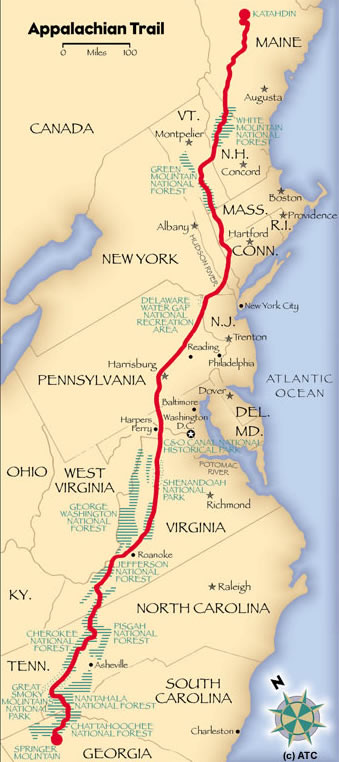

Trail Map
place your mouse over the trail on the map to the right in order to display images along the route or download the detailed map below as an easy to read PDF.
Trail hikers who attempt to complete the entire trail in a single season are called "thru-hikers"; those who traverse the trail during a series of separate trips are known as "section-hikers". Rugged terrain, weather extremes, freedom from illness or injury, and the desire to commit the time and effort required make thru-hiking difficult to accomplish. Traditionally, only about 10% to 15% of those who make the attempt report to the Appalachian Trail Conservancy that they completed it. However, since 2001, the number of people starting out in Georgia to do a thru-hike (or at least registering to do so) has dropped considerably, yet the number of people reporting that they have completed a thru-hike has remained approximately the same. This has resulted in an apparent increase in the completion rate to 29% (as of 2006). A thru-hike generally requires five to seven months, although some have done it in three months, and several trail runners have completed the trail in less time. Trail runners typically tackle the AT with automobile support teams, without backpacks, and without camping in the woods. The current speed record for thru-hiking the AT was set by Jennifer Pharr Davis in 2011, at 46 days, 11 hours, and 20 minutes. Pharr Davis made the trip southbound, from mid June to late July. Thru-hikers are classified into many informal groups. "Purists" are hikers who stick to the official AT trail, follow the white blazes, except for side trips to shelters and camp sites. "Blue Blazers" cut miles from the full route by taking side trails marked by blue blazes. The generally pejorative name "Yellow Blazers," a reference to yellow road stripes, is given to those who hitchhike to move down the trail. Most thru-hikers walk northward from Georgia to Maine, and generally start out in early spring and follow the warm weather as it moves north. These "north-bounders" are also called NOBO (NOrthBOund) or GAME (Georgia(GA)-to-Maine(ME)), while those heading in the opposite direction are termed "south-bounders" (also SOBO or MEGA). Part of hiker subculture includes making colorful entries in logbooks at trail shelters, signed using pseudonyms called trail names. The Appalachian Trail Conservancy gives the name "2000 Miler" to anyone who completes the entire trail. The ATC's recognition policy for "2000 Milers" gives equal recognition to thru-hikers and section-hikers, operates on the honor system, and recognizes blue-blazed trails or officially required road-walks as substitutes for the official, white-blazed route during an emergency such as a flood, forest fire, or impending storm on an exposed, high-elevation stretch. As of 2010, more than 11,000 people had reported completing the entire trail. About three-quarters of these are thru-hikers. The Appalachian Trail, the Continental Divide Trail, and the Pacific Crest Trail form what is known as the Triple Crown of long distance hiking in the United States. In 2001, Brian Robinson became the first one to complete all three trails in a year.

